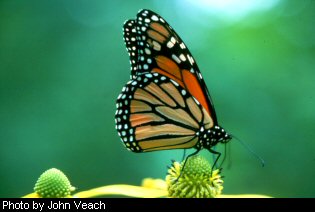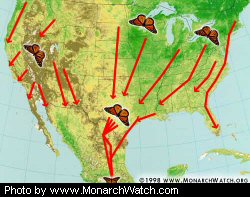Monarchs On The Move
By Nanci Bross-Fregonara
 It happens every autumn. Millions of monarchs pass through the East Coast on their way to Mexico on a fantastic voyage over mountains and water. These beautiful, delicate creatures that barely weigh a whisper travel over 3,000 miles from Canada to the conifers of the Sierra Madre Mountains to continue their species survival. It happens every autumn. Millions of monarchs pass through the East Coast on their way to Mexico on a fantastic voyage over mountains and water. These beautiful, delicate creatures that barely weigh a whisper travel over 3,000 miles from Canada to the conifers of the Sierra Madre Mountains to continue their species survival.
This migration has been going on for thousands of years, but when one reflects on the effort, even the most learned butterfly biologist ( or lepidoptologist ) is impressed. Tom Allen, a DNR biologist and author of The Butterflies of West Virginia and Their Caterpillars, recalls a meeting at Pipestem State Park in the 1970s when hundreds passed by a conference room. “They flew right over the building, two and three at a time, all in the same direction, for what seemed a long period of time,” Allen recalls. “It just had me in awe.”
This annual trip, triggered by a chemical response to the shortening of days, begins in late summer in the northernmost part of the Monarch's range in Canada, with butterflies passing through West Virginia in late September and early October. And there are hundreds of millions of them. “It takes a huge population to begin with because many of them die on the way,” Allen says. “They need three generations of butterflies during the spring and summer to strengthen their numbers for the migration.”
The reason for that is simple: just consider the trip. As the monarchs pass over land they have to deal with hunger, cars and predation . “They catch thermals, or warm air currents, just as hawks do,” Allen explains, “so they don't have to beat their wings.” But that doesn't make the trip easy. Traveling over the Gulf of Mexico they are threatened by  storms and exhaustion, taking breaks at surprising stopovers. They often congregate in large numbers on oil rigs. “This all seems so amazing when you stop to think that a little butterfly can go that far,” Allen says. storms and exhaustion, taking breaks at surprising stopovers. They often congregate in large numbers on oil rigs. “This all seems so amazing when you stop to think that a little butterfly can go that far,” Allen says.
As they enter Mexico, they head for the Sierra Madres where efforts to protect their habitat have been growing stronger, making it a hotspot for environmental activity. Eco-tourism is growing in that area of the country as naturalists flock to witness the migration first-hand.
Allen points out that most of the big conservation groups are working on finding environmentally friendly ways to bring money into the area. “Timbering is the main industry of the area so alternative economic incentives are needed in order to protect the Monarchs' habitat,” Allen explains. Some areas have already been set up as preserves, providing some protection.
While Monarchs are roosting in the fir forests found at 10,000 feet in elevation, they are in a state of diapause or dormancy; waking only to get water. While they are in this dormant state, they continue to store fats for their long voyage back across the Gulf.
The same trigger that sent the monarchs southward, works again in reverse, usually in February. The longer light and warmer temperatures tell the butterflies it is time to go. How they know where to go still remains a mystery to biologists. But by May, the Monarchs begin to appear in West Virginia, although not in the same number as in the past.
“I often heard anecdotes about great numbers flocking near people's clotheslines and at Finzel Swamp in western Maryland,” Allen says. “But now the Monarch's numbers are down.” Most biologists attribute this downward trend to weather patterns, including a freak winter storm this past January that killed several million of the 100 million Monarchs that overwintered in forests just west of Mexico City. “It's hard to predict their future because we have another El Nino coming up and weather patterns have been fluctuating a great deal,” he adds. Fortunately the number of Monarchs overwintering in the Sierra Madres during that disastrous freeze was high. If they had been at the previous year's level, it would have taken several years to restore the population.
When they do pass through the Central Appalachians in the fall, they are heading in a southwesterly direction finding places to roost in the evenings. A roosting site will have shelter from strong winds and good nectar sources nearby such as asters, chrysanthemums and other fall flowers. “It is important that gardeners think not only of summer flowering plants for butterflies, but also fall flowers that will help provide the necessary nectar for the long voyage south,” Allen says.
Nearly half of the migrating Monarch's eight-month life cycle is spent “on the road.” For the species to perpetuate, it has to make it to the nectar sources in the southern United States to reproduce in early spring. It is then that new brood that completes the rest of the journey to the northern states.
“Gardeners need to provide enough flowers to serve as host plants at the reproductive stage. Often the food for the larvae is the most critical,” he explains. “Monarchs lay their eggs on milkweed, upon which the larvae feed.” Loss of milkweed in the United States has also been cited as detrimental to Monarch populations.
The Monarch, like all our butterflies, provides not only beauty to the landscape but is also an important pollinator and “sensitive indicator of environmental quality,” Allen says. “Their migration has been going on for centuries and must continue,” he adds. “Hopefully with today's conservation movement, we will not lose this beautiful butterfly.”
Nanci Bross-Fregonara is a publications specialist in Elkins. |



